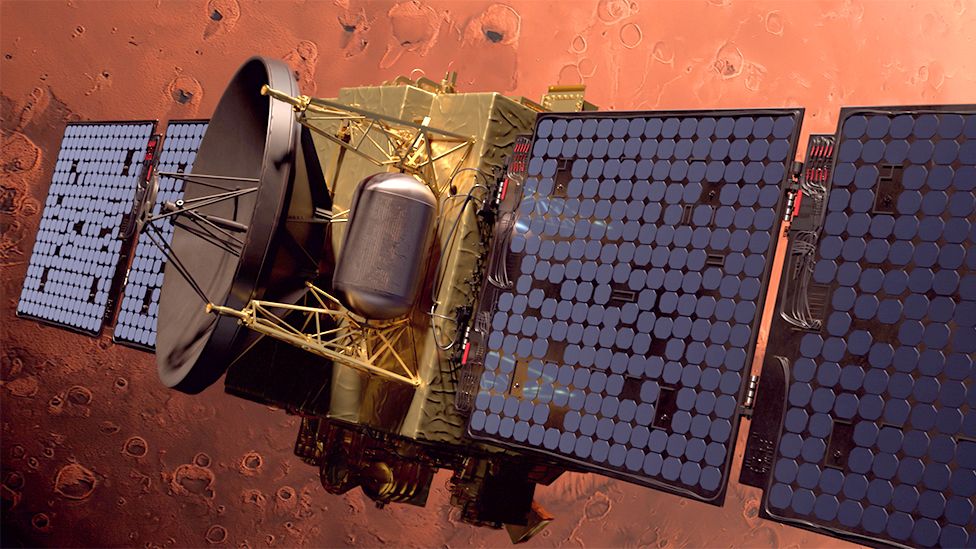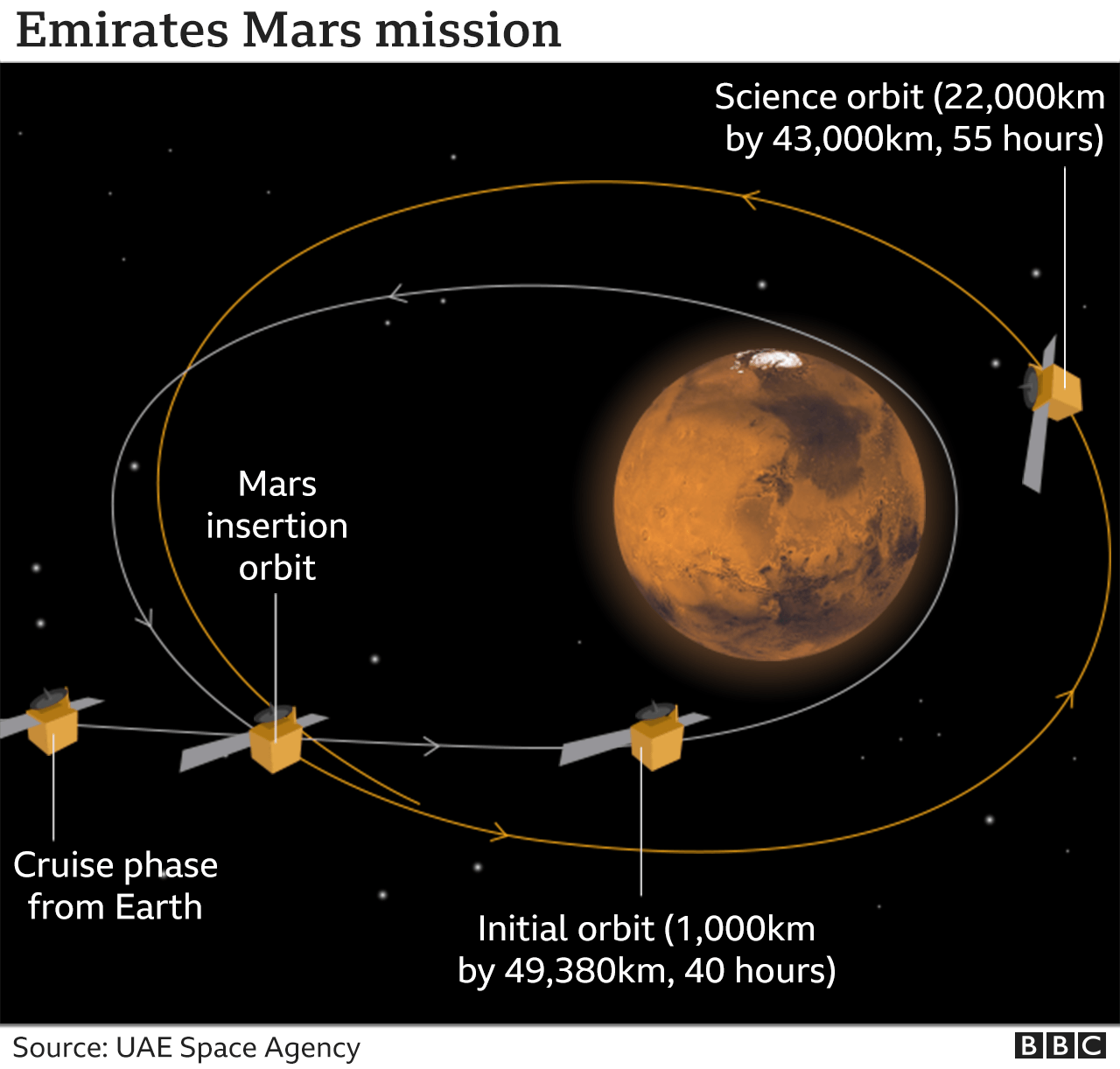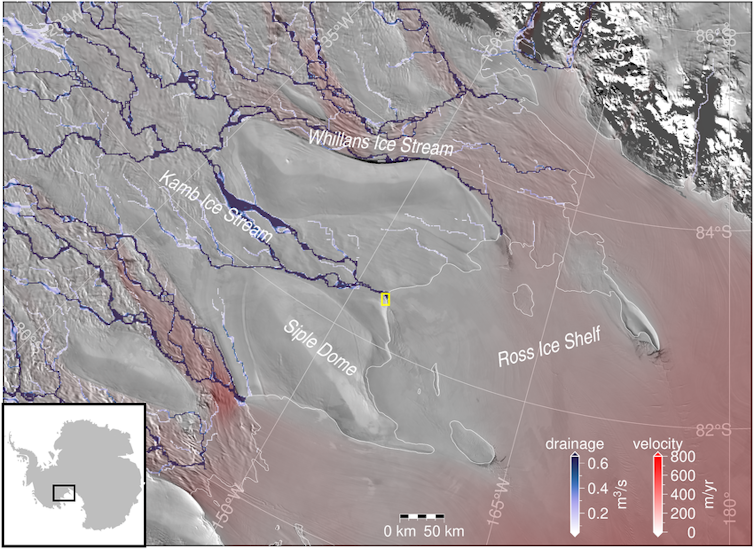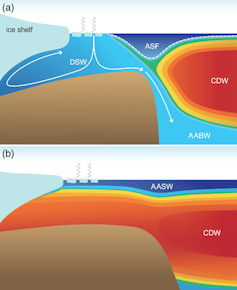Science
Emirates Mars Mission: Hope probe lines up historic Mars manoeuvre – BBC News


History beckons for the United Arab Emirates as it seeks on Tuesday to place a probe around Mars.
The Hope spacecraft, launched from Earth seven months ago, is about to reach the decisive moment in its long journey – orbit insertion.
Success would enable Hope to begin its mission to study Mars’ climate.
“We’re entering a very critical phase,” said project director, Omran Sharaf. “It’s a phase that basically defines whether we reach Mars, or not; and whether we’ll be able to conduct our science, or not.
“If we go too slow, we crash on Mars; if we go too fast, we skip Mars,” he told BBC News.
Hope is the first of three missions to arrive at the Red Planet this month. On Wednesday, the Chinese Tianwen-1 orbiter will also try to make it into orbit, while the Americans turn up on the 18th with another big rover.


For Hope, everything rides on Tuesday’s orbit insertion manoeuvre. In the past couple of months, engineers have trimmed the spacecraft’s trajectory so that it reaches the planet at precisely the right moment in space and time to begin the braking burn.
The approach speed needs to come down to about 18,000km/h.
Mission control at the Mohammed bin Rashid Space Center (MBRSC) in Dubai will have some data streaming back on the performance of Hope’s thrusters, but there is nothing anyone can do to intervene if something goes awry.
Mars and Earth are presently separated by 190 million km, meaning it would take a radio command fully 11 minutes to reach the probe – too long to make a difference. Hope must rely on autonomy to complete the manoeuvre.
“It’s definitely going to be nerve-racking; just thinking about it gives me goose-bumps,” said propulsion engineer Ayesha Sharafi. “But we do have a fault-protection system in place that can compensate for any problems that might happen during the burn, so I think we’re in a good position for Mars obit insertion to happen successfully.”
The confirmation signal that the braking burn has started should be received at Earth just after 19:40 Gulf Standard Time (15:40 GMT). This will come through the US space agency’s (Nasa) Deep Space Network of radio dishes.
Hope carries roughly 800 kilos of fuel. About half this mass will be consumed by the six thrusters involved in the 27-minute-long manoeuvre.
Shortly after the engines shut down, the spacecraft will disappear behind Mars as its trajectory bends into the planned initial orbit. Once again, there will be an anxious wait at the MBRSC while the team hangs on Nasa’s dish network re-acquiring Hope’s signal.
If Tuesday’s efforts are successful they will be rewarded with some fascinating science in the months ahead.


Hope can be described as a kind of weather or climate satellite for Mars.
More specifically, it’s going to study how energy moves through the atmosphere – from bottom to top, at all times of day, and through all the seasons of the year.
It will track features such as lofted dust which on Mars hugely influences the temperature of the atmosphere.
It will also look at what’s happening with the behaviour of neutral atoms of hydrogen and oxygen right at the top of the atmosphere. There’s a suspicion these atoms play a significant role in the ongoing erosion of Mars’ atmosphere by the energetic particles that stream away from the Sun.
This plays into the story of why the planet is now missing most of the water it clearly had early in its history.
To gather its observations, Hope will take up a near-equatorial orbit that stands off from the planet at a distance of 22,000km to 44,000km.


This means we will get spectacular images of the whole of the Red Planet on a routine basis.
“Any image we got of Mars would be iconic but I just can’t imagine what it’s going to feel like to get that first full-disk image of Mars, once we’re in orbit,” said Sarah Al Amiri, the Emirati minister of state for advanced technology and chair of the UAE Space Agency.
“And for me also, it’s getting that science data down and having our science team start analysing it and finding artefacts that haven’t been discovered before.”
The excitement across the nation is palpable. Buildings are being lit up in red. The UAE is banking on this mission being an inspiration to its youth and Arab youth in general to take up STEM subjects in school and at higher education levels.


The mission was initiated six years ago to come to fruition at the time of the UAE’s golden jubilee (The federation was founded on 2 December 1971). Having only recently started (2009) flying satellites at Earth, the nation didn’t have the full skill-set to mount an interplanetary mission.
The Emiratis therefore approached a number of US research institutions to engage them in a mentoring role. The American institutions include the University of Colorado at Boulder; Arizona State University; and the University of California, Berkeley.
“It’s been fun on a personal level, it’s been fun on a technical level, and seeing everybody’s personal abilities grow has been tremendously fulfilling,” said Pete Withnell, the Hope programme manager at Colorado’s Laboratory for Atmospheric and Space Physics.
“There are now lifelong personal friendships that will go forward long after this mission.”
Science
"Hi, It's Me": NASA's Voyager 1 Phones Home From 15 Billion Miles Away – NDTV

<!–
Launched in 1977, Voyager 1 was mankind’s first spacecraft to enter the interstellar medium
Washington, United States:
NASA’s Voyager 1 probe — the most distant man-made object in the universe — is returning usable information to ground control following months of spouting gibberish, the US space agency announced Monday.
The spaceship stopped sending readable data back to Earth on November 14, 2023, even though controllers could tell it was still receiving their commands.
In March, teams working at NASA’s Jet Propulsion Laboratory discovered that a single malfunctioning chip was to blame, and devised a clever coding fix that worked within the tight memory constraints of its 46-year-old computer system.
window._rrCode = window._rrCode || [];_rrCode.push(function() (function(v,d,o,ai)ai=d.createElement(“script”);ai.defer=true;ai.async=true;ai.src=v.location.protocol+o;d.head.appendChild(ai);)(window, document, “//a.vdo.ai/core/v-ndtv/vdo.ai.js”); );
“Voyager 1 spacecraft is returning usable data about the health and status of its onboard engineering systems,” the agency said.
Hi, it’s me. – V1 https://t.co/jgGFBfxIOe
— NASA Voyager (@NASAVoyager) April 22, 2024
“The next step is to enable the spacecraft to begin returning science data again.”
Launched in 1977, Voyager 1 was mankind’s first spacecraft to enter the interstellar medium, in 2012, and is currently more than 15 billion miles from Earth. Messages sent from Earth take about 22.5 hours to reach the spacecraft.
Its twin, Voyager 2, also left the solar system in 2018.
Both Voyager spacecraft carry “Golden Records” — 12-inch, gold-plated copper disks intended to convey the story of our world to extraterrestrials.
These include a map of our solar system, a piece of uranium that serves as a radioactive clock allowing recipients to date the spaceship’s launch, and symbolic instructions that convey how to play the record.
The contents of the record, selected for NASA by a committee chaired by legendary astronomer Carl Sagan, include encoded images of life on Earth, as well as music and sounds that can be played using an included stylus.
window._rrCode = window._rrCode || [];_rrCode.push(function(){ (function(d,t) var s=d.createElement(t); var s1=d.createElement(t); if (d.getElementById(‘jsw-init’)) return; s.setAttribute(‘id’,’jsw-init’); s.setAttribute(‘src’,’https://www.jiosaavn.com/embed/_s/embed.js?ver=’+Date.now()); s.onload=function()document.getElementById(‘jads’).style.display=’block’;s1.appendChild(d.createTextNode(‘JioSaavnEmbedWidget.init(a:”1″, q:”1″, embed_src:”https://www.jiosaavn.com/embed/playlist/85481065″,”dfp_medium” : “1”,partner_id: “ndtv”);’));d.body.appendChild(s1);; if (document.readyState === ‘complete’) d.body.appendChild(s); else if (document.readyState === ‘loading’) var interval = setInterval(function() if(document.readyState === ‘complete’) d.body.appendChild(s); clearInterval(interval); , 100); else window.onload = function() d.body.appendChild(s); ; )(document,’script’); });
Their power banks are expected to be depleted sometime after 2025. They will then continue to wander the Milky Way, potentially for eternity, in silence.
(Except for the headline, this story has not been edited by NDTV staff and is published from a syndicated feed.)
Science
West Antarctica's ice sheet was smaller thousands of years ago – here's why this matters today – The Conversation


As the climate warms and Antarctica’s glaciers and ice sheets melt, the resulting rise in sea level has the potential to displace hundreds of millions of people around the world by the end of this century.
A key uncertainty in how much and how fast the seas will rise lies in whether currently “stable” parts of the West Antarctic Ice Sheet can become “unstable”.
One such region is West Antarctica’s Siple Coast, where rivers of ice flow off the continent and drain into the ocean.
Journal of Geophysical Research, CC BY-SA
This ice flow is slowed down by the Ross Ice Shelf, a floating mass of ice nearly the size of Spain, which holds back the land-based ice. Compared to other ice shelves in West Antarctica, the Ross Ice Shelf has little melting at its base because the ocean below it is very cold.
Although this region has been stable during the past few decades, recent research suggest this was not always the case. Radiocarbon dating of sediments from beneath the ice sheet tells us that it retreated hundreds of kilometres some 7,000 years ago, and then advanced again to its present position within the last 2,000 years.
Figuring out why this happened can help us better predict how the ice sheet will change in the future. In our new research, we test two main hypotheses.
Read more:
What an ocean hidden under Antarctic ice reveals about our planet’s future climate
Testing scenarios
Scientists have considered two possible explanations for this past ice sheet retreat and advance. The first is related to Earth’s crust below the ice sheet.
As an ice sheet shrinks, the change in ice mass causes the Earth’s crust to slowly uplift in response. At the same time, and counterintuitively, the sea level drops near the ice because of a weakening of the gravitational attraction between the ice sheet and the ocean water.
As the ice sheet thinned and retreated since the last ice age, crustal uplift and the fall in sea level in the region may have re-grounded floating ice, causing ice sheet advance.

AGU, CC BY-SA
The other hypothesis is that the ice sheet behaviour may be due to changes in the ocean. When the surface of the ocean freezes, forming sea ice, it expels salt into the water layers below. This cold briny water is heavier and mixes deep into the ocean, including under the Ross Ice Shelf. This blocks warm ocean currents from melting the ice.

AGU, CC BY-SA
Seafloor sediments and ice cores tell us that this deep mixing was weaker in the past when the ice sheet was retreating. This means that warm ocean currents may have flowed underneath the ice shelf and melted the ice. Mixing increased when the ice sheet was advancing.
We test these two ideas with computer model simulations of ice sheet flow and Earth’s crustal and sea surface responses to changes in the ice sheet with varying ocean temperature.
Because the rate of crustal uplift depends on the viscosity (stickiness) of the underlying mantle, we ran simulations within ranges estimated for West Antarctica. A stickier mantle means slower crustal uplift as the ice sheet thins.
The simulations that best matched geological records had a stickier mantle and a warmer ocean as the ice sheet retreated. In these simulations, the ice sheet retreats more quickly as the ocean warms.
When the ocean cools, the simulated ice sheet readvances to its present-day position. This means that changes in ocean temperature best explain the past ice sheet behaviour, but the rate of crustal uplift also affects how sensitive the ice sheet is to the ocean.

Veronika Meduna, CC BY-SA
What this means for climate policy today
Much attention has been paid to recent studies that show glacial melting may be irreversible in some parts of West Antarctica, such as the Amundsen Sea embayment.
In the context of such studies, policy debates hinge on whether we should focus on adapting to rising seas rather than cutting greenhouse gas emissions. If the ice sheet is already melting, are we too late for mitigation?
Our study suggests it is premature to give up on mitigation.
Global climate models run under high-emissions scenarios show less sea ice formation and deep ocean mixing. This could lead to the same cold-to-warm ocean switch that caused extensive ice sheet retreat thousands of years ago.
For West Antarctica’s Siple Coast, it is better if we prevent this ocean warming from occurring in the first place, which is still possible if we choose a low-emissions future.
Science
NASA's Voyager 1 resumes sending engineering updates to Earth – Phys.org


For the first time since November, NASA’s Voyager 1 spacecraft is returning usable data about the health and status of its onboard engineering systems. The next step is to enable the spacecraft to begin returning science data again. The probe and its twin, Voyager 2, are the only spacecraft to ever fly in interstellar space (the space between stars).
Voyager 1 stopped sending readable science and engineering data back to Earth on Nov. 14, 2023, even though mission controllers could tell the spacecraft was still receiving their commands and otherwise operating normally. In March, the Voyager engineering team at NASA’s Jet Propulsion Laboratory in Southern California confirmed that the issue was tied to one of the spacecraft’s three onboard computers, called the flight data subsystem (FDS). The FDS is responsible for packaging the science and engineering data before it’s sent to Earth.
The team discovered that a single chip responsible for storing a portion of the FDS memory—including some of the FDS computer’s software code—isn’t working. The loss of that code rendered the science and engineering data unusable. Unable to repair the chip, the team decided to place the affected code elsewhere in the FDS memory. But no single location is large enough to hold the section of code in its entirety.
So they devised a plan to divide affected the code into sections and store those sections in different places in the FDS. To make this plan work, they also needed to adjust those code sections to ensure, for example, that they all still function as a whole. Any references to the location of that code in other parts of the FDS memory needed to be updated as well.


The team started by singling out the code responsible for packaging the spacecraft’s engineering data. They sent it to its new location in the FDS memory on April 18. A radio signal takes about 22.5 hours to reach Voyager 1, which is over 15 billion miles (24 billion kilometers) from Earth, and another 22.5 hours for a signal to come back to Earth. When the mission flight team heard back from the spacecraft on April 20, they saw that the modification had worked: For the first time in five months, they have been able to check the health and status of the spacecraft.
During the coming weeks, the team will relocate and adjust the other affected portions of the FDS software. These include the portions that will start returning science data.
Voyager 2 continues to operate normally. Launched over 46 years ago, the twin Voyager spacecraft are the longest-running and most distant spacecraft in history. Before the start of their interstellar exploration, both probes flew by Saturn and Jupiter, and Voyager 2 flew by Uranus and Neptune.
Provided by
NASA
Citation:
NASA’s Voyager 1 resumes sending engineering updates to Earth (2024, April 22)
retrieved 22 April 2024
from https://phys.org/news/2024-04-nasa-voyager-resumes-earth.html
This document is subject to copyright. Apart from any fair dealing for the purpose of private study or research, no
part may be reproduced without the written permission. The content is provided for information purposes only.
-
Business18 hours ago
Honda to build electric vehicles and battery plant in Ontario, sources say – Global News
-



 Science19 hours ago
Science19 hours agoWill We Know if TRAPPIST-1e has Life? – Universe Today
-
Investment22 hours ago
Down 80%, Is Carnival Stock a Once-in-a-Generation Investment Opportunity?
-



 Health18 hours ago
Health18 hours agoSimcoe-Muskoka health unit urges residents to get immunized
-



 Health15 hours ago
Health15 hours agoSee how chicken farmers are trying to stop the spread of bird flu – Fox 46 Charlotte
-



 Investment17 hours ago
Investment17 hours agoOwn a cottage or investment property? Here's how to navigate the new capital gains tax changes – The Globe and Mail
-
News23 hours ago
Honda expected to announce multi-billion dollar deal to assemble EVs in Ontario
-



 Science24 hours ago
Science24 hours agoWatch The World’s First Flying Canoe Take Off






